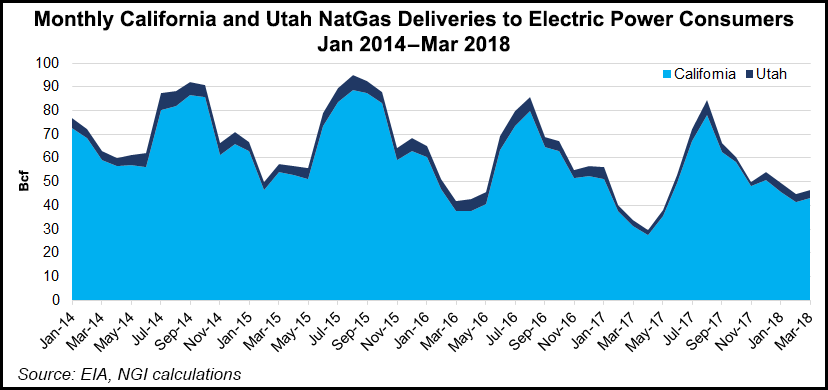Regulatory | NGI All News Access | NGI The Weekly Gas Market Report
LADWP Utah Gas-Fired Generation Plans Scaled Back by Oversight Board
The oversight board for the Los Angeles Department of Water and Power (LADWP), the nation’s largest municipal utility, on Tuesday scaled back long-standing plans for a new natural gas-fired power plant in Utah as a replacement for the utility’s coal-fired generation.

The action by the five-member Board of Water and Power Commissioners comes amid criticism from environmental groups who want renewables to replace LADWP’s supplies from the Intermountain Power Project (IPP) at Delta, UT. Moves have been underway for nearly a decade for the multi-billion dollar utility to retire its out-of-state coal-fired generation.
A smaller planned power plant does not require any other city approvals, but the proposal does require unanimous approval of the IPP/Intermountain Power Agency (IPA) board, which is scheduled to take up the issue in August, according to a LADWP spokesperson. “It will allow us to fully phase out of coal from IPP by 2025,” he said.
Instead of a 1,200 MW gas-fired plant that was approved by city and utility officials three years ago, LADWP’s board approved pursuing an 840 MW gas-fired project to be ready by July 1, 2025, when LADWP cuts its ties to IPP’s coal-fired generation. Part of the LADWP board’s action supports a scaled-back approach to the 35-member IPP repowering and increasing renewable-based power supplies flowing through the renewable transmission grid hub developed at Delta
“LADWP proposes to accelerate the de-carbonization of its resource mix by making earlier reductions of fossil fuels and front-loading more renewable resources into its power mix,” the utility spokesperson said.
LADWP General Manager David Wright told the board that replacing the Intermountain supplies with nothing but renewables was neither practically or technologically feasible. Representatives from the Sierra Club and Food & Water Watch called a move from “coal-to-methane” a bad plan.
During its meeting Tuesday, the city utility board also moved to increase LADWP’s renewable goals for 2025 and 2036 to 55% and 70%, respectively. “This accelerates the de-carbonization of [our] power supply by increasing the [renewable portfolio standard] targets by 5%, starting in 2025,” the spokesperson said.
An agreement in 2016 with Phoenix-based Salt River Project (SRP) for 477 MW of the Navajo’s coal-fired generation plant output in Arizona allowed LADWP to meet California climate change goals ahead of schedule and reduce the city’s portion of coal-fired power until it phases it out entirely in 2025.
The municipal utility’s plan in 2011 was to phase out coal and build up gas-fired generation. At the time, LADWP’s generation mix was led by coal (39%), with natural gas (24%) next and renewables the third largest source (20%). The plans called for the mix shifting dramatically with natural gas becoming the source for nearly half of the utility’s power (47%), renewables providing one-third and coal being totally phased out by 2030.
LADWP continues to push toward ending its use of coal-fired power by 2025.
Twenty-three small municipal utilities and six rural cooperatives in Utah depend on IPP for most, if not all, of their power supplies, and they have expressed concerns with the plans beyond 2027. IPP, through the IPA, is preparing potential contracts with all of the California and Utah customers, contemplating gas-fired generation with a total capacity of about 1,300-1,400 MW.
© 2024 Natural Gas Intelligence. All rights reserved.
ISSN © 1532-1231 | ISSN © 2577-9877 | ISSN © 1532-1266 |
